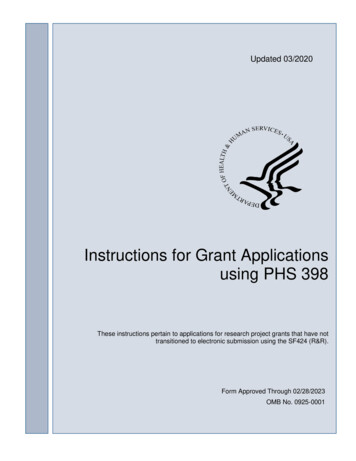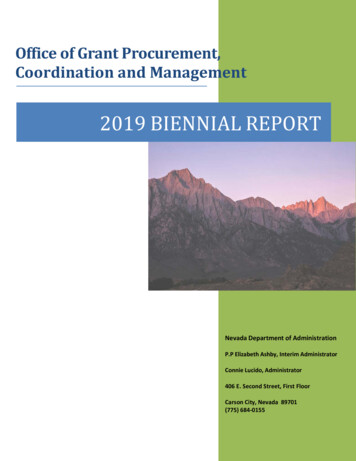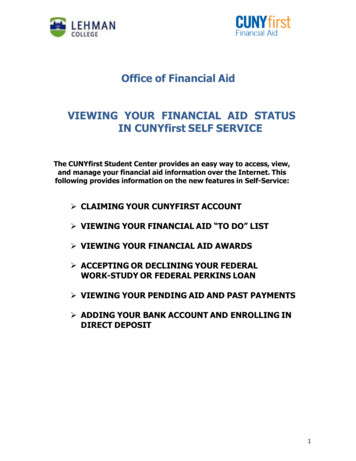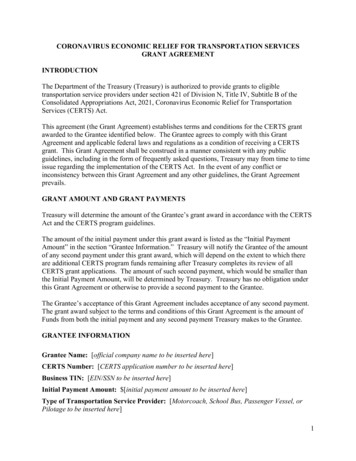
Transcription
Updated 03/2020Instructions for Grant Applicationsusing PHS 398These instructions pertain to applications for research project grants that have nottransitioned to electronic submission using the SF424 (R&R).Form Approved Through 02/28/2023OMB No. 0925-0001
Table of ContentsPART I.INSTRUCTIONS FOR PREPARING AND SUBMITTING AN APPLICATION1. Foreword . 11.11.21.31.41.51.61.71.8(Reserved) . 2NIH Extramural Research and Research Training Programs. 2Research Grant Programs and Program Guidelines . 2Interactions with PHS Staff . 2Grants Policy Statements . 5References. 5Authorization . 71.7.1 Collection of Personal Demographic Data . 7Paperwork Burden . 72. General Instructions . 152.16Introduction . 8Registration Processes . 82.2.1 (Reserved) . 82.2.2 (Reserved) . 8(Reserved) . 8Funding Opportunities . 82.4.1 NIH Guide for Grants and Contracts. 92.4.2 Funding Opportunity Announcements (FOAs) . 9(Reserved) . 9Format Specifications . 9“Resubmission” Applications . 9“Revision” Application. 9Similar, Essentially Identical, or Identical Applications . 9(Reserved) . 10(Reserved) . 10(Reserved) . 10Post-Submission Application Materials . 10Application Due Dates . 10Submission, Review and Award Cycles . 10Resources for Finding Help . 112.16.1 (Reserved) . 112.16.2 Finding Help for the eRA Commons Registration . 112.16.3 Finding Help for Application Preparation . 113. Submission of the Grant Application . 113.13.23.33.4Cover Letter . 12Number of Copies . 12Bindings and Packaging . 12Application Mailing Address . 13ii
4. Completing the PHS 398 Forms and Format Pages . 144.14.24.34.44.54.64.74.8Face Page. 14Summary, Relevance, Project/Performance Sites, Senior/Key Personnel, Other SignificantContributors, and Human Embryonic Stem Cells. 20Project Summary and Relevance . 20Project/Performance Site(s) . 20Scientific/key Personnel . 21Other Significant Contributors . 21Human Embryonic Stem Cells . 21Research Grant Table of Contents . 21Budget Instructions . 22Budget for Entire Proposed Project Period Direct Costs Only. 25Biographical Sketch . 254.6.1 Other Support Information . 29Resources . 29All Personnel Report . 305. Preparing the Research Plan, the Checklist, and the Appendix . 315.15.25.35.45.55.65.7(Reserved) . 31(Reserved) . 31(Reserved) . 31Research Plan Format and Notice of Proprietary Information . 315.4.1 Research Plan Format . 315.4.2 Notice of Proprietary Information . 31Content of Research Plan . 325.5.1 Introduction (Resubmission or Revision Applications only) . 335.5.2 Specific Aims . 335.5.3 Research Strategy . 335.5.4 Bibliography and References Cited/Progress Report Publication List . 355.5.5 Vertebrate Animals . 365.5.6 Select Agent Research. 365.5.7 Multiple Project Director/Principal Investigator (PD/PI) Leadership Plan . 375.5.8 Consortium/Contractual Arrangements . 375.5.9 Letters of Support. 385.5.10 Resource Sharing Plan(s) . 385.5.11 Authentication of Key Biological and/or Chemical Resources . 395.5.12 PHS Human Subjects and Clinical Trials Information . 39Checklist . 39Appendix . 406. Peer Review Process . 41iii
Instructions for Preparing and Submittinga Paper Application
1.ForewordThe PHS 398 instructions contain information for preparing grant applications to the National Institutesof Health (NIH) and other Public Health Service (PHS) agencies. These instructions pertain toapplications for research project grants that have not transitioned to electronic submission using theSF424 (R&R).Applicants to PHS agencies other than NIH should contact the agency using the PHS AgencyContacts Table in 1.4 below because some awarding components have application requirements thatdiffer from those for NIH.NIH continues to transition grant activity codes from the PHS 398 to the SF424 (R&R) and electronicsubmission through Grants.gov. The PHS 398 is required for all grant activity codes that have nottransitioned to the SF424 (R&R). Once an activity code has transitioned to electronic submission, allapplications to that code must be an electronic application submission via forms that are provided apart of the electronic application packages, either through the NIH ASSIST system, an institutionalsystem-to-system solution, or the Grants.gov Workspace.Information on Transition Strategy and Timeline can be found at the Timeline of NIH Transitions to ElectronicSubmission of Competing Grant Applications. Bookmark the PHS 398 Grant Application website for easy electronicaccess to this document.Policy ChangesThis 03/2020 revision only updates the OMB expiration date to 02/28/2023.These instructions incorporate numerous clarifications, updates and policy announcements that haveappeared in the NIH Guide for Grants and Contracts since the 03/2016 revision of the PHS 398application. Since the Guide also publishes multiple funding opportunity announcements (FOA), theOffice of Extramural Research posts Policy Notices, clarifications, and other updates on this webpage:NIH Policy Notices. Applicants are expected to be aware of any relevant Notices that appear in theGuide.Substantive changes to instructions and form pages fall into the following categories and arehighlighted as follows:Biographical Sketch Updated biosketch instructions so that scholastic performance requires onlyscientific/professional graduate courses to be listedResearch Plan PHS Inclusion Enrollment Report: Discontinued use (data collection moved to new PHSHuman Subjects and Clinical Trials Information form)PHS Human Subjects and Clinical Trials Information form There is a new form for consolidated human subjects, inclusion enrollment report, and clinicaltrial information. Includes attachment to comply with NIH Policy on the Use of a Single Institutional ReviewBoard for Multi-Site Research. Includes the updated appendix policy that eliminates clinical trial-related materials. See theNIH Guide Notice on Allowable Appendix Materials for more information.PHS 3981
Important Reminders for All ApplicantsPrepare a succinct Research Plan and follow the Table of Page Limits unless the FOA specifiesotherwise. Sections 4-11 of the Research Plan have no maximum allowable pages, but should also besuccinct.Several elements of an application are not required at the time the application is submitted. Thisinformation is requested later in the review cycle (i.e., just-in-time) to ensure that it is current. See NIHGrants Policy Statement, Section 2.5.1: Just-in-Time Procedures.1.1 (Reserved)1.2 NIH Extramural Research and Research Training ProgramsThe NIH Office of Extramural Research is the focal point for policies and guidelines for extramuralresearch grants administration.The Division of Communications and Outreach (DCO) is the central source for general informationabout NIH extramural research and research training programs, funding activity codes, the peerreview system, and application procedures. Grants Information (GrantsInfo) is a communicationservice within the DCO. Information about the NIH extramural research and research trainingprograms, funding opportunities, and the grant application process, can be obtained by e-mailing yourrequest to: GrantsInfo@nih.gov, or calling 301-945-7573.1.3 Research Grant Programs and Program GuidelinesFor a complete listing of program guidelines, visit the Types of Grant Programs page.1.4 Interactions with PHS StaffApplicants are strongly encouraged to communicate with PHS staff throughout the entireapplication, review and award process. Web site addresses and staff phone numbers of relevant NIHawarding components and other PHS agencies are listed in the table below.All inquiries regarding the assignment, review, or recommendation on funding of applications are to bemade only to PHS officials.PHS Agency ContactsPHS AGENCYPHS 398AWARDING COMPONENTTELEPHONENUMBERNIHNational Institutes of Health (NIH)301-496-4000NIHEunice Kennedy Shriver National Institute of ChildHealth and Human Development301-496-0104NIHFogarty International Center301-496-1653NIHNational Cancer Institute301-496-3428NIHNational Center for Complementary and IntegrativeHealth301-496-4792NIHNational Center for Advancing Translational Sciences301-496-6023NIHNational Eye Institute301-451-2020NIHNational Heart, Lung, and Blood Institute301-435-02602
PHS AGENCYAWARDING COMPONENTTELEPHONENUMBERNIHNational Human Genome Research Institute301-496-7531NIHNational Institute on Aging301-496-9322NIHNational Institute on Alcohol Abuse and Alcoholism301-443-4375NIHNational Institute of Allergy and Infectious Diseases301-496-7291NIHNational Institute of Arthritis and Musculoskeletal andSkin Diseases301-594-2463NIHNational Institute of Biomedical Imaging andBioengineering301-451-4792NIHNational Institute on Deafness and OtherCommunication Disorders301-496-1804NIHNational Institute of Dental and Craniofacial Research301-594-4800NIHNational Institute of Diabetes and Digestive and KidneyDiseases301-594-8834NIHNational Institute on Drug Abuse301-443-2755NIHNational Institute of Environmental Health Sciences919-541-7723NIHNational Institute of General Medical Sciences301-594-4499NIHNational Institute of Mental Health301-443-3367NIHNational Institute on Minority Health and HealthDisparities301-402-1366NIHNational Institute of Neurological Disorders and Stroke301-496-9248NIHNational Institute of Nursing Research301-594-6906NIHNational Library of Medicine301-496-4621NIHCenter For Scientific Review301-435-0715AGENCY FOR HEALTHCARERESEARCH AND QUALITY (AHRQ)Agency for Healthcare Research and Quality301-427-1447CENTERS FOR DISEASE CONTROLAND PREVENTION (CDC)Coordinating Center for Health Information and Services404-498-1186CDCOffice of Infectious Disease404-639-3770CDCNational Center for Environmental Health770-488-4668CDCNational Center for Injury Prevention and Control770-488-8390CDCNational Center for Chronic Disease Prevention andHealth Promotion404-639-4621CDCNational Institute for Occupational Safety and Health404-498-2530CDCProcurement and Grants Office770-488-2700FOOD AND DRUG ADMINISTRATIONFood and Drug Administration301-827-7185INDIAN HEALTH SERVICEIndian Health Service301-443-0578AGENCY FOR TOXIC SUBSTANCESAND DISEASE REGISTRYAgency for Toxic Substances and Disease Registry404-842-6630OFFICE OF PUBLIC HEALTH ANDSCIENCEOffice of Population Affairs240-453-2800OFFICE OF PUBLIC HEALTH ANDSCIENCEOffice of Family Planning240-453-2888PHS 3983
BEFORE SUBMISSIONApplicants are strongly encouraged to contact NIH staff with their questions before submitting anapplication. Contact GrantsInfo at 301-945-7573 or email GrantsInfo@nih.gov, and/or the Division ofReceipt and Referral in the Center for Scientific Review (CSR) at 301-435-0715:oTo identify Institutes/Centers (ICs) at NIH or other non-NIH agencies, and/or aScientific Review Group (SRG), that might be appropriate for the application. Notethat requests for assignment to an IC and/or a SRG may be made in a cover letter(See section 3.1 Cover Letter) at the time of application submission.oTo learn about grant programs.oTo receive advice on preparing and submitting an application (e.g., format,structure).Contact program staff in the relevant awarding component:oTo determine whether a proposed application topic would fit into the NIH IC or othernon-NIH agency's programmatic area.oTo learn about programmatic areas of interest to the IC or other non-NIH agencies.oTo find out about requesting an assignment to an IC.oTo discuss responding to a Request for Applications.Contact Scientific Review Officers (SRO) in the Center for Scientific Review to discussrequesting assignment to a CSR SRG.AFTER SUBMISSIONIf the initial assignment to an IC or SRG seems inappropriate, the Program Director/PrincipalInvestigator (PD/PI) may request reassignment. Such requests should be made in writing to:Division of Receipt and ReferralCenter for Scientific ReviewNational Institutes of Health6701 Rockledge Drive, Suite 2030, MSC 7720Bethesda, MD 20892-7720Fax requests (301-480-1987) are also acceptable.Although these requests will be carefully considered, the final determination will be made by the PHSagency.Applicants must never contact reviewers regarding their applications because discussion of the scientific contentof an application or an attempt to influence review outcome will create serious breaches of confidentiality in thereview process. Reviewers are required to notify the Scientific Review Officer if they are contacted by an applicant.Communication by the applicant to a reviewer may delay the review or result in the return of the application withoutreview.Communications from the Division of Receipt and Referral (DRR) are accessible to applicants andapplicant organizations in the eRA Commons in the “Correspondence” section of the Commonsdetailed status screen for the application. Applicants will be notified by email to check their Commonsaccount. DRR will notify an applicant when: 1) additional information is required before her/hisapplication can be assigned to a scientific review group (SRG) and NIH Institute or Center (IC) forPHS 3984
funding consideration; 2) an applicant’s request for an IC assignment cannot be honored; or 3) it hasbeen determined that the application does not comply with NIH policy. For additional information, seeeRA’s Status Information page.AFTER ASSIGNMENTContact the SRO to discuss the review assignment, to request permission to sendadditional/corrective materials, and/or to discuss any review concerns (e.g., expertise needed on theSRG, conflicts, reviewers that may have bias).AFTER PEER REVIEWFeedback to applicants is very important. Once the PD/PI reviews the Summary Statement in the eRACommons (paper copies of the Peer Review Outcome Letter and Summary Statement will not bemailed to the PI. Electronic copies may be accessed through the eRA Commons), the appropriateawarding component program official (noted in the Summary Statement) may be contacted: To discuss the review outcome of the application and obtain guidance. To get feedback and answers to any questions about the Summary Statement. To find out the meaning of a numerical designation pertaining to human subjects or vertebrateanimals on the Summary Statement. To find out the funding status of an application.The Peer Review Outcome Letter and Summary Statement will not be mailed to the PD/PI and mayonly be accessed through the eRA Commons.1.5 Grants Policy StatementsThe NIH Grants Policy Statement serves as a term and condition of award and is a compilation of thesalient features of policies and various policy issues regarding the administration of NIH awards.The HHS Grants Policy Statement serves as a term and condition of award and is a compilation of thesalient features of policies and various policy issues regarding the administration of grant awards fromother PHS agencies, excluding NIH awards.1.6 ReferencesApplicants New to NIH: Getting StartedGetting Started at NIH websiteAward Information and DataResearch Portfolio Online Reporting Tool (RePORT)Contact Information for an NIH Staff PersonNIH Enterprise Directory (NED)NIH locator: 301-496-4000eRA CommonseRA Commons websiteInstitutions and Program Directors/Principal Investigators (PD/PIs) are required to register withthe eRA Commons. Registered PD/PIs can check assignment/contact information, reviewoutcome, and other important information.PHS 3985
Call the Service Desk at 1-800-504-9552 (toll-free) or 301-402-7469. Business hours are M-F7am-8pm Eastern Time.eRA Service Desk online request formGrant Writing Tips and Sample ApplicationsGrant Writing Tips SheetsGrants Process OverviewGrants InformationWelcome to NIH Grants Information pageE-mail: GrantsInfo@nih.govTelephone: 301-945-7573NIH Grants and Funding Help PageContacting NIH Staff at the NIH Institutes and Centers pageThis site provides a self-help wizard to guide inquiries to the correct NIH website for additionalinformation on specific topics.NIH Office of Extramural Research Human Subjects WebsiteResearch Involving Human Subjects websiteThis site provides HHS and NIH requirements and resources for the extramural communityinvolved in human subjects research.Biosafety, Biosecurity, and Emerging BiotechnologyBiosafety, Biosecurity, and Emerging Biotechnology websiteNIH Guidelines for Research Involving Recombinant or Synthetic Nucleic Acid Molecules (NIHGuidelines), dual use research of concern (DURC), and the NIH Stem Cell RegistryTelephone: 301-496-9838Office for Human Research Protections (Department of Health and Human Services)Office for Human Research Protections websiteInformation about human subject protections, Institutional Review Boards, and Federal WideAssurances.Telephone: 1-866-447-4777 or 301-496-7005Office of Laboratory Animal Welfare (OLAW)Office of Laboratory Animal Welfare websiteInformation about animal welfare policy requirements, Institutional Animal Care and UseCommittees (IACUC), and Animal Welfare Assurances.Telephone: 301-496-7163Receipt/Referral of an ApplicationCSR’s The Assignment Process pageDivision of Receipt and ReferralCenter for Scientific ReviewTelephone: 301-435-0715Fax: 301-480-1987Specific Application: Before ReviewPHS 3986
Telephone or e-mail the Scientific Review Officer identified for the application in the eRACommons.Specific Application: Post ReviewTelephone or e-mail the NIH Program Official named in the Summary Statement for theapplication.1.7 AuthorizationThe PHS requests the information described in these instructions pursuant to its statutory authoritiesfor awarding grants, contained in Sections 301 (a) and 487 of the PHS Act, as amended (42 USC241a and 42 USC 288). Therefore, such information must be submitted if an application is to receivedue consideration for an award. Lack of sufficient information may hinder the ability of the PHS toreview an application and to monitor the grantee’s performance.1.7.1 Collection of Personal Demographic DataFederal agencies have a continuing commitment to monitor the operation of its review and awardprocesses to detect, and deal appropriately with, any instances of real or apparent inequities. Inaddition, section 403 of the 2007 NIH Reform Act requires NIH to report to Congress specifically onpostdoctoral individuals supported on research grants, and section 489 of the PHS Act requires NIHto perform a continuing assessment of research personnel needs. Personal demographic data onPD/PIs and those with a postdoctoral role is vital to comply with these requirements.NIH collects personal data through the eRA Commons Personal Profile. The data is provided one-timeby the individual through a secure electronic system and is confidential. The NIH maintains applicationand grant records as part of a system of records as defined by the Privacy Act: NIH htm. When completing the data entry in the CommonsPersonal Profile, the individual is responsible for providing true, accurate, and complete data. Allanalyses conducted on date of birth, citizenship, gender, race, ethnicity, disability, and/ordisadvantaged background data will report aggregate statistical findings only and will not identifyindividuals. Declining to provide information does not affect consideration of an application; however,for some programs (e.g., Ruth L. Kirschstein National Research Service Awards and ResearchCareer Development Awards) citizenship data is required to determine eligibility.The PHS also requests the last four digits of the Social Security Number (SSN) for accurateidentification of individuals and for management of PHS grant programs. Please be aware that noindividual will be denied any right, benefit, or privilege provided by law because of refusal to disclosethis portion of the SSN. The PHS requests the last four digits of the SSN under Section 301(a) and487 of the PHS act as amended (42 U.S.C. 241a and U.S.C. 288).1.8 Paperwork BurdenThe PHS estimates that it will take approximately 35 hours to complete this application for a regularresearch project grant. This estimate excludes time for development of the scientific plan. Other itemssuch as human subjects are cleared and accounted for separately and therefore are not part of thetime estimate. An agency may not conduct or sponsor the collection of information unless it displaysa currently valid OMB control number. Nor is a person required to respond to requests for thecollection of information without this control number. Send comments regarding this burden estimateor any other aspect of this collection of information, including suggestions for reducing this burden, to:NIH, Project Clearance Office, 6705 Rockledge Drive MSC 7974, Bethesda, MD 20892-7974, ATT:PRA (0925-0001). Do not send applications to this address.PHS 3987
2.General Instructions2.1 IntroductionRead all of the instructions thoroughly prior to application preparation.These instructions pertain to applications for research project grants that have not transitioned toelectronic submission using the SF424 (R&R).For other specialized grants or cooperative agreements, request additional instructions from theappropriate NIH awarding component or other PHS agency. Phone numbers for contacting theappropriate staff are listed in the Agency Contact Table. For further assistance, contact:GrantsInfoNational Institutes of Health (NIH)E-mail: GrantsInfo@nih.govPhone: 301-435-0714Read and follow the instructions carefully to avoid delays, misunderstandings and possible return ofthe application. Adherence to font and margin requirements is necessary for several reasons. Noapplicant should have an advantage over other applicants by providing more content using smaller,denser type. Small type sizes may also make it difficult for reviewers to read the application.The NIH Center for Scientific Review (CSR), Division of Receipt and Referral, has the responsibility tomake the final determination of legibility and the authority to return applications. This decision is finaland not subject to appeal. Inquiries should be directed to the:CSR, Division of Receipt and ReferralPhone: 301-435-0715; TTY 301-451-5936; Fax: 301-480-19872.2 Registration ProcessesPlease refer to Prepare to Apply-Register page for more information about registering theOrganization/Organization Representative, as well as Investigators and other individual users.2.2.1 (Reserved)2.2.2 (Reserved)2.3 (Reserved)2.4 Funding OpportunitiesGrants for health-related research and research training projects or activities make up the largestcategory of funding provided by the NIH Institutes/Centers (ICs) and other non-NIH agencies. Mostapplications for support are unsolicited and originate with individual investigators who developproposed plans for research or research training within an area that is relevant to the NIH. Researchproject grants are awarded to organizations/institutions on behalf of PD/PIs to facilitate the pursuit of ascientific objective when the idea for the research is initiated by the investigator. If the funding agencyanticipates substantial program involvement during the conduct of the research, a cooperativePHS 3988
agreement will be awarded, rather than a grant. The NIH typically awards grants and cooperativeagreements for terms ranging from one to five years. Organizational/institutional sponsorship assuresthat the awardee organization will provide the facilities and the financial stability necessary to conductthe research, and be accountable for the funds. For more detailed information, visit the Types of GrantPrograms page.2.4.1 NIH Guid
The PHS 398 instructions contain information for preparing grant applications to the National Institutes of Health (NIH) and other Public Health Service(PHS) agencies. . research grants administration. The Division of Communications and Outreach (DCO) is the central source for general information . Agency for Healthcare Research and Quality .











